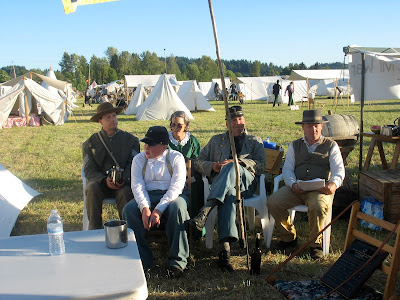We had a blast, as always, in spite of being next to a food vendor with a loud generator, and with cars parked just at the end of our row - reminded me of Gettysburg!
This is Captain Kyle, from our Federal unit. He's hanging out with us as a Confederate private. I fed him a bayonet breakfast of these neat little pre-made egg cups. I'm not really one for getting up early to stoke the fires, so pre-made breakfasts are the way to go around here.
Morning inspection.
With, as always, the hand slap game.
Private Calvin Kirkland.
Captain, um Private Kyle taught the fellows how to stack bayonets properly.
Isn't our young Corporal just the cutest?
And he let me fire his pistol, which was really fun! Check out my new secession apron, featuring the Bonnie Blue Flag.
We were invited to dinner on Saturday night with the 20th Maine. Yes, the folks that slaughtered us, both historically on Little Round Top, and last May at base ball. They made up for it splendidly by feasting us royally on ribs, baked potatoes, coleslaw, potato salad, cake and blueberry cobbler. Then they played music and we all sang together.
These tables were filled from end to end at dinner. The Yankees began with some pre-planned speeches and toasts. At one point, we were supposed to declare the motto of the state of Alabama as "for the heart of Dixie" or something similar. But that's not the motto, so Captain Brock declared "We dare defend our rights." The Maine Captain looked slightly disconcerted.
Captain Brock.
Sergeant Lawless.
Sergeant Newton.
A full moon.
Polly, (Mrs. Sergeant Newton.)
Private Calvin Kirkland.
Hailey and friends, off to the dance.
The Yankees even played "Bonnie Blue Flag" for us!
Sunday morning Tai Chi.
This is Miss Sarah, our vivandiere. Vivandière is a French name for women attached to military regiments as sutlers or canteen keepers. During the American Civil War, many patriotic women on both sides served as vivandières.
Lieutenant and Private Rounds.
The Privates Barry.
Splendid new recruits.
Clarence is very excited to have her own dog tent.
On Sunday, Captain Kyle reverted to the Federal side, but not without a proper goodbye from Alabama.
Rufus looks a tad gleeful, don't you think?
On Sunday, our Hannah helped carry a wounded Clarence off the field on a stretcher.
Poor Corporal Long died on my skirt.
Because the 20th Maine made dinner on Saturday, I didn't have to cook, but I wanted to anyway, so I made macaroni and cheese for lunch, along with "Co K Corn," a receipt (recipe) I got from our Federal unit. I love cooking in the 1860s.
Possibly the best part of the whole weekend was dinner on Sunday night. After packing up, we went out to dinner with Rufus, Capt Kyle and barefoot Donny, another Federal friend, who is exactly like a grown-up Brennan. The food was good, the jokes flew, and we all had a wonderful time. Brennan now calls shoes "foot prisons."
And in three weeks we'll do it all again!






















































